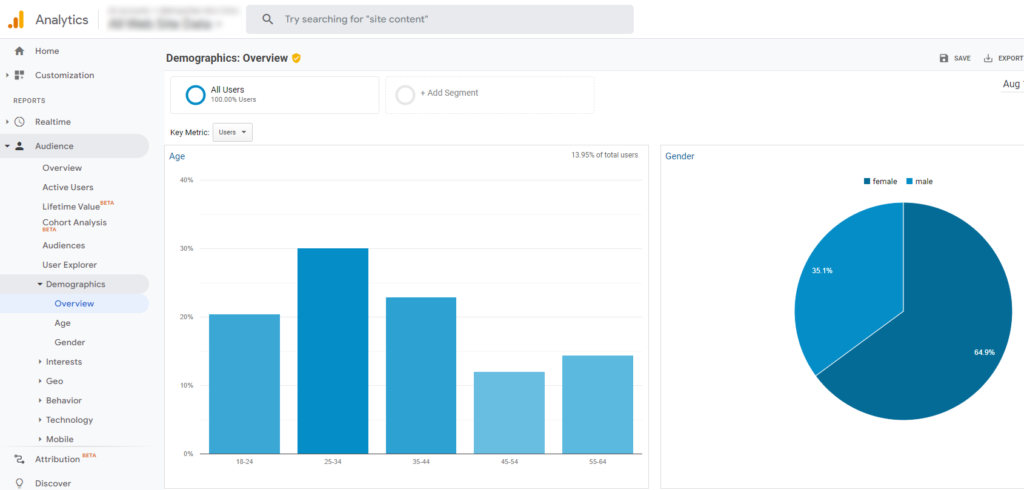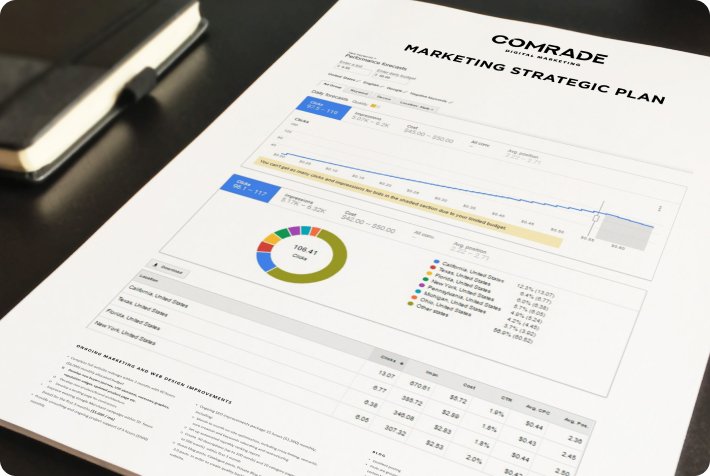Google Tag Manager vs. Analytics: Which is better? It’s a trick question — they’re both excellent marketing tools!
While they sound similar and are free and developed by Google, they have plenty of differences. Google Analytics is an analysis tool for websites, whereas Google Tag Manager is a marketing tag manager.
Interestingly, over 80% of websites use Google Analytics (GA) to understand more about the traffic coming to their sites, whereas 99% of websites use Google Tag Manager (GTM). These statistics prove just how effective both these digital tools are.
In this blog, we explain GTM vs. GA in terms of what they do, how they work, and why you should use both.
What Is Google Analytics?

Google Analytics is the world’s most trusted and renowned free web analytics service offered by Google as a platform inside the Google Marketing Platform brand. Broadly speaking, it provides insightful target audience data for search engine optimization (SEO) and improving digital marketing ROI.
Businesses use this cloud-based software to gauge the success of their digital marketing activities, track customer goal completions, and identify macro and micro trends in consumer behavior.
With Google Analytics, you can identify opportunities to boost conversions, improve customer engagement, understand how visitors experience your website, and gain access to actionable data that turns profit.
Data plays a vital role in all digital marketing strategies, and having the right monitoring tools can make or break business growth. Because Google Analytics is part of Google’s search engine, it’s optimized to react timeously to the ever-changing online landscape. Plus, it’s user-friendly: one can easily learn the basics by studying a Google Analytics guide.
Therefore, its power lies not only in its impressive tracking capabilities, but also in how it conveniently aggregates, filters, and visualizes data. As the go-to analytics tool, it’s indispensable in understanding your business’s online performance. That’s why over 40 million companies from Uber to Airbnb use it in their tech stacks.
What Is Google Tag Manager?

To understand what Google Tag Manager (GTM) does, you first have to understand what a tag is. Tags, in the context of Google, are segments of JavaScript code that use cookies to track customer behavior like clicks, purchases, and time spent on web pages.
Tags then report this information to the service that provided the tag, which stores and analyzes the information. They can also integrate valuable third-party content like social media and ad campaigns. In reality, tags should accompany every piece of online communication to provide access to additional website data to identify optimization opportunities.
Google Tag Manager is also a free tool that manages and deploys marketing tags on your website and content marketing assets without having to modify any code. The difference between Google Tag Manager vs. Analytics is that GTM is essentially the mediator between your website and the tracking tool, i.e., Google Analytics.
In other words, Google Tag Manager sends the data from your website to Google Analytics (or other tools) where it is collected, stored, and analyzed. Like Google Analytics, Google Tag Manager is easy to use, which is why so many companies rely on it to manipulate numerous tags and improve digital campaign monitoring from a single interface.
Why Do Google Tag Manager and Google Analytics Get Confused With Each Other?
When it comes to Google Tag Manager vs. Google Analytics one would be mistaken comparing the two, as they’re designed to complete different tasks and accomplish different goals. To break it down: Google Tag Manager implements and manages scripts (tracking codes), whereas Google Analytics collects and reports on these tracking codes.
The confusion tends to come with the implementation of Google Analytics. It’s possible to install Analytics through Google Tag Manager. However, you can also install it directly onto your website, which makes sense if Analytics is your only tracking tool as you can control and monitor everything from a single interface.
However, if you’re using multiple tracking tools or have complicated event tracking (monitoring multiple things happening on a single web page) it makes sense to install GTM on your website and then link it to your Analytics account. Consequently, this is more complicated, but it provides additional advanced tracking options and is compatible with multiple tools.
Both types of implementation work. The one you choose depends on your business’s tracking plan. Marketers will typically install GTM if they’re planning to use Facebook Pixel, Google Ads, or Microsoft Advertising.
The Difference Between Google Tag Manager and Google Analytics
GTM and GA combined are a powerful tracking and reporting duo. To be clear: They’re not a replacement for each other. As such, marketers use both to enhance user experience, monitor traffic, and refine their sales funnels.
Furthermore, you don’t have to use Google Tag Manager, meaning, you can add Google Analytics tracking code directly to your website’s source code—just bear in mind; you lose flexibility.
So, what’s the main difference between Google Analytics vs. Tag Manager?
Google Analytics’ main job is generating reports and statistics about your website. The only way it can do this is if you put a “tag” on all your pages that run on your visitors’ browsers, and feed GA data. You can put a tag on the master file of your website in GA.
However, if you want to group certain pages together or track how many visitors use specific features, you need unique tags for all these interactions and page groups, so Google can identify the right interaction.
Google Tag Manager makes this process easier by letting you define the rules for when certain Google Analytics Tags should be activated. Although unlike Google Analytics, it has no reporting features, all it does is add tracking, web analytics, and measurement codes to any website or application.
The Difference in Events Set Up
According to Google, an event is “when a user interacts with a component of your website.” For example, submissions, video plays, purchases, etc. To track events, a snippet of custom code is added to the link code on the items you want to track on your website, and when the item is clicked, it’s tracked and displayed as an event in Google Analytics.
Events consist of four elements:
- Category (required): The name you give to a group of objects you wish to track.
- Action (required): The type of interaction, like sending a completed submission form.
- Label (optional): Helps summarize what the event is about.
- Value (optional): Used to assign a numeric value to your completed form submission.
When the event fires on your website, these labels and attributed values pop up in Google Analytics. You can manually customize the links on your website, or you can use Google Tag Manager to store all these tags in one place.
Historically, GA tracking code had to be coded statically, usually by a web developer. You can imagine how tedious this was if marketers were tracking several events on a single page.
Instead, Google Tag Manager stores all your tags in one place. You can also test tags with a visual tool as you navigate around your site to ensure they’re triggered when an event takes place.
It’s important to note that although the term “event” is the same in both GA and GTM, with Google Tag Manager it’s a triggering condition, while a Google Analytics event is a tag.
Remember, a tag is a code that sends data to Analytics, while a trigger is set to fire (activates) during certain events. When an event is detected that matches a specific trigger, like downloading a page, any tags that reference that trigger are activated.
Google Analytics Goals and Conversions
Google Analytics monitors campaign success by tracking conversions which are defined as important actions or engagements you want your website visitors to complete. These can range from subscribing to a newsletter to starting a free trial or calling your business.
When Google Analytics was updated in 2020 to Google Analytics 4 (GA4), it removed the distinction between goals and events. Currently, you measure all conversions (key website actions) via GA4 Events.
Technically, Google Tag Manager has no relationship with Google Analytics. It merely transports data to Google Analytics. What Google Analytics deems as important data for your business is reliant on how you configure conversions within Analytics. Therefore, GTM is merely a valuable conduit to get the data you want to collect into Analytics.
For example, if you wish to measure how many people click on a video on your website you can assign a tag to the video, which will only fire (activate) when a visitor plays the video. The tag won’t work for any other interaction.
Setting the tag perimeters (rules) is done within the Tag Manager. The tag collects the number of times the action occurs (visitors play the video), and sends it to GA, which is specifically configured to collate this data.
Conclusion
Deploying both GA and GTM offers far more detailed information and a better overall picture of your marketing efforts. Using events and triggers provides vital information like how many people are viewing a page, watching a video, or completing a purchase.
If you’re not a coder or marketer and feel overwhelmed by Google Tag Manager and Analytics, that’s perfectly okay. Your business can still derive the benefits by working with a professional digital marketing company like ours.
Comrade’s analytics specialists can install these tools on your behalf, analyze the data, and boost online conversions with a comprehensive digital marketing strategy. Contact us today to learn how we can develop and implement data-driven digital marketing for your business.




